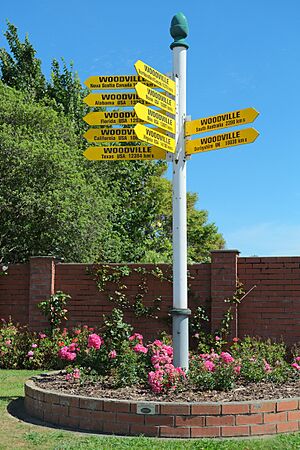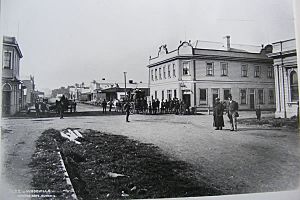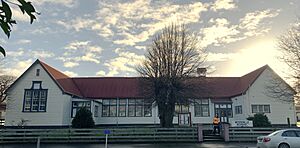Woodville, New Zealand facts for kids
Quick facts for kids
Woodville
|
|
|---|---|
|
Town
|
|

Woodville fingerpost
|
|
| Country | New Zealand |
| Region | Manawatū-Whanganui |
| Territorial authority | Tararua District |
| Ward |
|
| Electorates |
|
| Area | |
| • Total | 4.04 km2 (1.56 sq mi) |
| • Land | 4.04 km2 (1.56 sq mi) |
| • Water | 0 km2 (0 sq mi) |
| Population
(June 2023)
|
|
| • Total | 1,670 |
| • Density | 413.4/km2 (1,071/sq mi) |
| Time zone | UTC+12 (NZST) |
| • Summer (DST) | UTC+13 (NZDT) |
| Postcode |
4920
|
Woodville, once called The Junction, is a small town in the southern North Island of New Zealand. It is about 75 kilometers north of Masterton and 25 kilometers east of Palmerston North. In 2013, about 1400 people lived in Woodville.
The town is part of the Tararua District and the Manawatū-Whanganui region. However, it has strong connections to the Hawke's Bay region, which it used to be a part of. Many people see Woodville as the northern edge of Wairarapa. It is also located near the Manawatū River.
Contents
- Exploring Woodville's Geography
- Woodville's Past: A Look at History
- Who Lives in Woodville? Demographics
- Woodville's Economy and Jobs
- Getting Around: Transportation
- Woodville's Culture and Arts
- Sports in Woodville
- Learning in Woodville: Education
- Woodville's Weather: Climate Information
- Famous People from Woodville
Exploring Woodville's Geography
Woodville covers an area of 4.04 square kilometers. Just a few kilometers west of Woodville, the Manawatū River flows through a deep gorge. This gorge cuts right through a mountain range. It's quite unusual because the river flows east towards the Pacific Ocean. Then, it turns west, goes through the gorge, and finally flows into the Tasman Sea near Foxton.
The Manawatū Gorge: Te Āpiti
The Māori name for the gorge is Te Āpiti. Māori stories say the gorge was formed by Okatia showing his strength on his way to the sea. A road and a railway line were built into the steep sides of the gorge. The gorge road is now closed for good. The Saddle Road and Pahiatua Track are now the main ways to travel between the east and west coasts of the southern North Island.
The Manawatū Gorge road was once a very important route. It connected Manawatū, Hawke's Bay, and Wairarapa. But because the land is unstable, the road will not reopen. A new four-lane road project was approved in 2019. It will be built near the existing Saddle Road and the Manawatū Gorge. This new road will connect to State Highway 2 west of Woodville.
Woodville's Past: A Look at History
Woodville is located at the northern end of the Tararua Range and the southern end of the Ruahine Ranges. In Māori history, this area was a resting place for travelers. It was also a spot where hunters would rest after crossing the Manawatū Gorge. The local Māori tribe was Rangitāne. They were known for having good relationships with other tribes.
Wharite Peak: A Mountain's Story
One important local landmark is Wharite Peak. It is one of the main peaks in the Ruahine Ranges. This mountain range stretches for 110 kilometers from the Manawatū Gorge. The name Wharite might come from the original name Wharetiti. "Whare" means house, and "titi" means muttonbird. Muttonbirds are also known as Sooty Shearwaters.
According to a 2009 radio interview, these birds used to nest on the ridges of the Ruahine mountain range. The birds would arrive at Wharetiti from Bare Island, Waimarama. Then, they would continue north towards Tongariro. Local Māori people would build temporary shelters when the titi birds arrived. They would gather the birds from their burrows. They preserved the birds in pouches made from bull kelp, which they brought from the coast. It has been many years since muttonbirds were last seen in this part of the Ruahines.
Who Lives in Woodville? Demographics
Woodville covers 4.04 square kilometers. As of 2023, it has an estimated population of about 1,770 people. This means there are about 438 people per square kilometer.
Population Changes Over Time
- In 2006, Woodville had 1,401 people.
- In 2013, the population was still 1,401 people.
- By the 2018 New Zealand census, the population grew to 1,548 people. This was an increase of 147 people (10.5%) since 2013.
In 2018, there were 648 households in Woodville. There were 777 males and 774 females. The average age was 44.9 years. About 20.3% of the people were under 15 years old. Another 20.3% were 65 years or older.
Ethnicities and Backgrounds
The people in Woodville come from different backgrounds:
- 81.8% were European/Pākehā.
- 26.0% were Māori.
- 3.1% were Pasifika.
- 3.3% were Asian.
- 1.7% were from other ethnic groups.
About 11.8% of people in Woodville were born outside New Zealand. This is lower than the national average of 27.1%.
Religious Beliefs
When asked about religion in the census:
- 52.3% said they had no religion.
- 31.4% were Christian.
- 2.5% had Māori religious beliefs.
- 0.4% were Hindu.
- 0.4% were Buddhist.
- 1.9% had other religions.
Education and Income
Among people aged 15 and older:
- 10.0% had a bachelor's degree or higher.
- 32.4% had no formal qualifications.
- The average income was $22,700.
- About 8.3% earned over $70,000.
For employment, 38.0% worked full-time. 14.6% worked part-time, and 4.4% were unemployed.
Woodville's Economy and Jobs
In 2018, many Woodville residents worked in different industries:
- 14.7% worked in manufacturing.
- 6.0% worked in construction.
- 5.5% worked in hospitality (hotels, restaurants).
- 6.5% worked in transport.
- 7.8% worked in education.
- 11.1% worked in healthcare.
Woodville became important in European history as a timber milling town. It was one of three large towns in the 'Seventy Mile Bush'. This bush stretched along the eastern side of the Tararua and Ruahine Ranges. The other towns were Dannevirke and Pahiatua.
Changes in Local Industries
As farms were set up, many small dairy factories opened. They processed milk into milk, cheese, and other dairy products. Even in the mid-1980s, the dairy factory in Woodville made cheese. It also had a shop selling dairy products directly to people.
Woodville also had a strong sheep and beef farming economy. This supported local trucking companies. However, after transport rules changed in the 1980s, Woodville's role as a transport hub became less important.
Many other businesses also closed over time. A supermarket closed for a while but later reopened. A factory that made carpets closed in the mid-1980s. Many service stations also closed, with only one remaining today. The railway also used to have a bigger presence.
New Economic Boosts
The Oringi Meatworks opened in 1980-81. This helped Woodville's economy because many local people worked there. However, the Oringi plant closed in 2008. Today, there is not much light industry left. Local farms now get support from larger towns like Palmerston North, Pahiatua, or Dannevirke.
A new boost to the local economy has come from the Te Āpiti Wind Farm. This wind farm is built on the ridges above the town. The lower hills of the Ruahine and Tararua mountain ranges are now covered with wind turbines. This is New Zealand's largest wind farm. It was built in the early 2000s.
The Manawatū region has strong westerly winds. These winds are perfect for generating electricity from wind. The flat lands of Manawatū and the "funnel effect" of the Manawatū Gorge mean the area often has high winds.
After careful testing in the early 1990s, two large wind farms were built on the ridge-lines. The Te Āpiti Wind Farm has 55 turbines. It generates about 90 megawatts of electricity. This is enough power for about 30,000 homes. Woodville first got electricity from the Mangahao hydro-electric power station in 1925.
Getting Around: Transportation
In 2018, most people in Woodville drove to work:
- 78.3% drove a car.
- 3.7% rode in a car.
- 0.9% used a bike.
- 0.9% walked or ran.
No one used public transport to get to work.
State Highway 3, which goes through the gorge, is closed. A new state highway will replace it in the 2020s.
Railway Connections
The Palmerston North - Gisborne railway line runs along the northern side of the river. At Woodville Railway Station, this line connects with the Wairarapa Line. There is also a special loop track called a balloon loop. This allows trains to turn around and travel through the Wairarapa to Wellington.
The northern part of the Wairarapa line does not have much train traffic. Sometimes, only one train a week uses the line. This train goes from Wellington to Napier. However, the line to Hawke's Bay was busy when Fonterra used it to transport milk from Oringi. Fonterra stopped using the Oringi milk transfer station in 2015-16.
Woodville's Culture and Arts
Te Ahu a Turanga i Mua marae is located on Tay Street. A marae is a tribal meeting ground for Māori people. This marae belongs to Rangitāne and its sub-tribes, Ngāti Te Koro and Ngāti Te Rangiwhakaewa. It includes the Te Ahu a Turanga i Mua meeting house.
Music and Art Connections
One of New Zealand's first international hit songs, Blue Smoke, was written by Ruru Karaitiana. He was born on a farm near Woodville and Dannevirke. Karaitiana served in the Māori Battalion during World War II. He wrote and recorded the song after returning to New Zealand. Famous artists like Dean Martin have also sung this song.
Woodville was also the original home of the Mountain Rock Music Festival. This festival celebrated New Zealand music. It grew to be the biggest New Zealand music festival in the 1990s.
The famous artist Gottfried Lindauer is buried in the local Old Gorge Cemetery.
Sports in Woodville
Woodville has produced several talented sportspeople, especially in the 1980s. Robert Collings Tennent started the first rugby club in New Zealand. He lived in Nelson at the time. He later moved to Woodville and is buried in the Old Gorge Cemetery.
Woodville is still home to a successful horse-racing industry. This includes horse rearing and training. The Woodville & Pahiatua Jockey Club has a track on the north-east side of town.
Motocross Excitement
Woodville has hosted the New Zealand MotoCross Grand Prix motorcycling races since 1961. This event is now seen as New Zealand's top motocross race. The Woodville Grand Prix takes place every January. It is held on the Cleghorn farm, near the eastern entrance to the Manawatū Gorge. The list of winners includes famous motorsport names, like Ken Cleghorn, whose family owns the farm. Another early racer was Tim Gibbes. He helped Hollywood actor Steve McQueen learn stunts for the movie The Great Escape.
Learning in Woodville: Education
Woodville School is a public primary school for students in Year 1 to 8. It teaches both boys and girls. As of 2023, about 170 students attend Woodville School.
Woodville's Weather: Climate Information
| Climate data for Woodville (1951–1980) | |||||||||||||
|---|---|---|---|---|---|---|---|---|---|---|---|---|---|
| Month | Jan | Feb | Mar | Apr | May | Jun | Jul | Aug | Sep | Oct | Nov | Dec | Year |
| Mean daily maximum °C (°F) | 19.3 (66.7) |
20.0 (68.0) |
18.6 (65.5) |
15.7 (60.3) |
12.5 (54.5) |
10.2 (50.4) |
9.6 (49.3) |
10.5 (50.9) |
12.3 (54.1) |
14.0 (57.2) |
16.0 (60.8) |
17.9 (64.2) |
14.7 (58.5) |
| Daily mean °C (°F) | 15.5 (59.9) |
15.9 (60.6) |
14.8 (58.6) |
11.9 (53.4) |
9.6 (49.3) |
7.5 (45.5) |
6.6 (43.9) |
7.5 (45.5) |
8.9 (48.0) |
10.5 (50.9) |
12.5 (54.5) |
14.2 (57.6) |
11.3 (52.3) |
| Mean daily minimum °C (°F) | 11.7 (53.1) |
11.8 (53.2) |
11.0 (51.8) |
8.1 (46.6) |
6.6 (43.9) |
4.8 (40.6) |
3.6 (38.5) |
4.5 (40.1) |
5.5 (41.9) |
7.0 (44.6) |
9.0 (48.2) |
10.5 (50.9) |
7.8 (46.1) |
| Average rainfall mm (inches) | 93 (3.7) |
85 (3.3) |
96 (3.8) |
94 (3.7) |
104 (4.1) |
103 (4.1) |
104 (4.1) |
103 (4.1) |
85 (3.3) |
111 (4.4) |
96 (3.8) |
117 (4.6) |
1,191 (47) |
| Mean monthly sunshine hours | 209 | 189 | 174 | 122 | 113 | 82 | 89 | 115 | 116 | 147 | 200 | 200 | 1,756 |
| Source: NIWA | |||||||||||||
Famous People from Woodville
- Rob Foreman: A rugby player for the Manawatu province.
- Dean Kenny: An All Black and Otago provincial rugby player.
- Atholstan Mahoney: An All Black and Bush provincial rugby player.
- Robbie McLean: An All Black and Wairarapa Bush and Manawatu provincial rugby player.
- Joe Schmidt: A rugby and basketball player. He was the head coach for the Ireland and Australian rugby teams.
- Rob Thompson: An All Black and provincial rugby player.
- Grant McNeil (Athletics): Competed in the 110 Hurdles for New Zealand at the 1990 Commonwealth Games.



